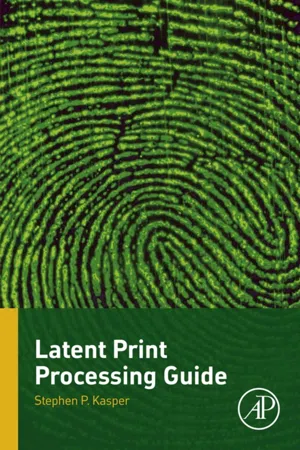
- 202 pages
- English
- ePUB (mobile friendly)
- Available on iOS & Android
Latent Print Processing Guide
About this book
Latent prints are chance or accidental impressions left by friction-ridge skin on a surface, regardless of whether they are visible or invisible at the time of deposition. Recognition of evidence that may contain fingerprints and the processes that can develop these latent prints is crucial in preventing valuable evidence from being left undetected. Latent Print Processing Guide goes beyond the basic police training, covering latent prints in detail and providing first responders with adequate training and guidelines. To process latent prints, examiners use various techniques including electronic, chemical, cyanoacrylate, and physical methods. Latent Print Processing Guide offers a broad understanding of latent print detection, development, and recovery, including insights on stateof-the-art technologies.- Includes history of latent print identification and some of the pioneers and their contributions. Defines the differences between chemical and physical processes and explains process sequence protocols and recovery methods for different types of evidence.- Chapters include: process selection, application and recovery, special considerations for specific materials, protocol sequence and process formulas, including required materials, application method, expected results, safety measures, and references.- The text is written so that non-crime scene or non-crime laboratory personnel can also gain valuable information from it.
Frequently asked questions
- Essential is ideal for learners and professionals who enjoy exploring a wide range of subjects. Access the Essential Library with 800,000+ trusted titles and best-sellers across business, personal growth, and the humanities. Includes unlimited reading time and Standard Read Aloud voice.
- Complete: Perfect for advanced learners and researchers needing full, unrestricted access. Unlock 1.4M+ books across hundreds of subjects, including academic and specialized titles. The Complete Plan also includes advanced features like Premium Read Aloud and Research Assistant.
Please note we cannot support devices running on iOS 13 and Android 7 or earlier. Learn more about using the app.
Information
The Forensic Science of Fingerprints
Abstract
Keywords
AFIS; Basis for use; Contaminant; Core; Definitions-Palmer; Delta; Fingerprint patterns; History; Identification process; Inked; Introduction; Latent; Matrix; Nonporous; Patent; Permanent; Plantar; Porous; UniqueFingerprints
Brief History
Definitions
Types of Fingerprints
Table of contents
- Cover image
- Title page
- Table of Contents
- Copyright
- Preface
- Acknowledgments
- Chapter 1. The Forensic Science of Fingerprints
- Chapter 2. Developing Fingerprints
- Chapter 3. Special Considerations
- Chapter 4. Process Sequence Protocols
- Chapter 5. The Processes
- Appendix A
- Appendix B
- Appendix C
- Index